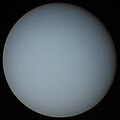天卫一
 天卫一艾瑞尔 | |
| 发现 | |
|---|---|
| 发现者 | 威廉·拉塞尔(William Lassell) |
| 发现日期 | 24 October 1851 |
| 编号 | |
| 其它名称 | Uranus I |
| 形容词 | Arielian |
| 轨道参数 | |
| 半长轴 | 191,020 km |
| 二次轨道半径 | 190,900 km |
| 离心率 | 0.0012 |
| 轨道周期 | 2.520 d |
| 轨道倾角 | 0.260° (与天王星赤道相比) |
| 隶属天体 | 天王星 |
| 物理特征 | |
| 大小 | 1162.2 × 1155.8 × 1155.4 km |
| 平均半径 | 578.9 km (0.0908 Earths) |
| 表面积 | 4,211,300 km² |
| 体积 | 812,600,000 km³ |
| 质量 | 1.35×1021 kg (地球的2.26×10-4) |
| 平均密度 | 1.67 g/cm³ |
| 表面重力 | 0.27 m/s2 |
| 0.56 km/s | |
| 自转周期 | 同步 |
| 反照率 | 0.39 |
| 温度 | ~58 K |
| 视星等 | 14.16 [1] |
天卫一(Ariel、发音为/ˈɛəriəl/)是天王星的卫星,它是威廉·拉塞尔(William Lassell)在1851年10月24日和天卫二一起发现的。
名称
艾瑞尔这个名称是从英国诗人亚历山大·蒲柏的诗《秀发劫》(The Rape of the Lock)中的精灵艾瑞尔而来的。它也是威廉·莎士比亚的作品《暴风雨》中精灵的名称。
天卫一与当时已知的4颗卫星都是由约翰·赫歇尔受到拉塞尔的请托而命名的[2]。拉塞尔在之前曾经称赞约翰·赫歇尔在1847年所采用的7颗土星卫星命名概念,而且1848年发现的土卫八也是参照这样的规则命名的。
特征
天卫一的首张近距离的详细照片是航海家二号于1986年飞掠过天王星时所摄得的,也是目前为止唯一的近距离照片。航海家二号在1986年1月24日最接近天卫一,当时距离为127,000公里[3]。因为当时天卫一的南极朝向太阳,所以只有拍摄到北半球的特征。
根据目前得到资料的误差范围,所以还无法确定天卫一的质量是否比天卫二还大[4]。天卫一大约有70%是由冰(水冰与二氧化碳冰,可能也有甲烷冰)所构成的,而30%则是硅酸盐(出现在新形成的霜附近,特别是年轻撞击坑洞的喷发物质中)。航海家二号观测到天卫一上最大及最古老的地质特征是靠近南极的火山平原。分析这个火山平原上的坑洞后得知,它们大部分都比天卫三、天卫四与天卫二上所观测的年轻[5]。航海家二号在天卫一上发现的最大坑洞是Yangoor,直径只有78公里[6],并显露出被破坏过的迹象。航海家二号也在南半球的中纬地区观测到断层、峡谷网络与冰流动的迹象,并破坏火山平原的地区的表面。这些峡谷可能代表由伸张大地构造所造成的地堑。在峡谷中也可以见到一些平滑的物质与沟槽,这可能表示一些地层中蕴含着温暖的冰(从天卫一内部所挤压出来的)[5]。
天卫一过去的地质活动被认为是受到潮汐加热的影响,当时它的轨道离心率比现在更大。在它的早期,天卫一似乎与天卫四产生4:1的轨道共振,虽然后来就没有产生这样的共振[7]。共振也增加了天卫一的轨道离心率,导致天王星对于天卫一的潮汐力并不稳定,也造成它内部的温度上升。在天王星的系统中,因为天王星的扁率比较小,而且卫星的体积相对较大,所以卫星从轨道共振中逃脱也比木星或土星的卫星要容易。
天卫一非常类似土星的卫星土卫四,它们的大小、密度与质量都相当类似,虽然天卫一在这些数据上都稍微超过土卫四。
目前从天卫一上发现下列的地形:
运行

哈伯太空望远镜在2006年7月26日观测一次相当罕见的现象:当时天卫一从天王星的盘面穿过,并在天王星的云层顶端留下影子。这样的现象仅会发生在昼夜平分点附近,因为卫星的轨道面与天王星的轨道面有97度的倾斜[8]在2007年12月的昼夜平分点,天卫一再度从天王星的盘面中心穿过[9]。。
参见
外部链接
- ^ Classic Satellites of the Solar System. Observatorio ARVAL. [2007-09-28]. (原始内容存档于2011-08-25).
- ^ http://adsabs.harvard.edu//full/seri/AN.../0034//0000169.000.html (页面存档备份,存于互联网档案馆) Adsabs.harvard.edu Retrieved on 06-01-07
- ^ Voyager Mission Description (页面存档备份,存于互联网档案馆). Accessed May 29, 2006
- ^ Planetary Satellite Physical Parameters. JPL (Solar System Dynamics). 2008-10-24 [2008-12-28]. (原始内容存档于2020-05-21).
- ^ 5.0 5.1 Smith, B. A., et al. (1982). "Voyager 2 in the Uranian system - Imaging science results (页面存档备份,存于互联网档案馆)". Science 233: 43-64.
- ^ Uranus System Nomenclature Table Of Contents. Gazetteer of Planetary Nomenclature. USGS Astrogeology. [2009-01-05]. (原始内容存档于2005-04-21).
- ^ Tittemore, W. C. Tidal Heating of Ariel. Icarus. 1990, 87: 110–139 [2009-02-21]. doi:10.1016/0019-1035(90)90024-4. (原始内容存档于2008-01-15).
- ^ Uranus and Ariel. Hubblesite (News Release 72 of 674). 2006-07-26 [2006-12-14]. (原始内容存档于2011-08-26).
- ^ Eclipse of the Sun by Ariel from the center of Uranus during equinox. JPL Solar System Simulator. 2007-December-10 01:48 UT [2008-06-07]. (原始内容存档于2012-12-13).
外部链接
- Ariel Profileby NASA's Solar System Exploration(页面存档备份,存于互联网档案馆)
- William Lassell, Astronomical Journal 2 (1851) 70 (页面存档备份,存于互联网档案馆)
- AN, 33 (1852) 257/258 (页面存档备份,存于互联网档案馆)
- AN, 34 (1852) 325/326 (页面存档备份,存于互联网档案馆)
- Ariel basemap derived from Voyager images
- NASA Archive of publicly released Ariel images
- 天卫一图片集
- 天卫一图片[永久失效链接]
| |||||||||
| |||||||||||||||||||||||||||
| ||||||||||||||||||||||||||||||||||||||||||
| ||||||||||||||||||||||||||||||
Text is available under the CC BY-SA 4.0 license; additional terms may apply.
Images, videos and audio are available under their respective licenses.




